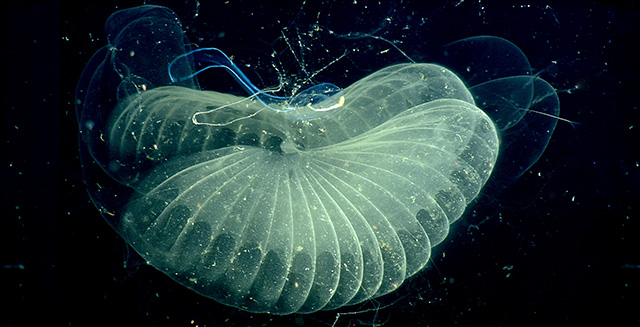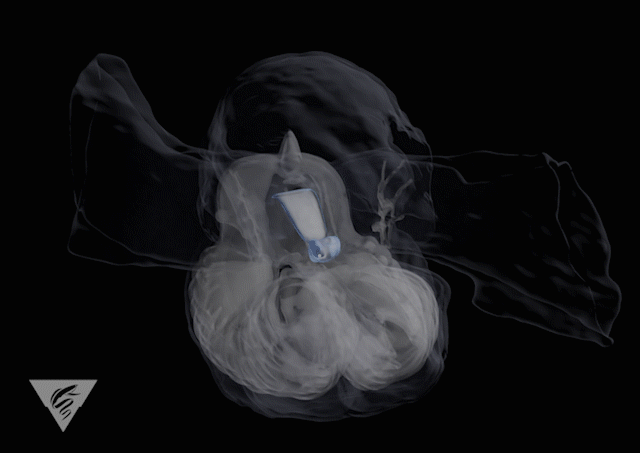These gorgeous, intricate sea creatures are actually giant blobs of snot
Scientists are using lasers to create 3D reconstructions of these creatures' mucus houses.

Hundreds of feet below the sea surface, teeny-tiny sea creatures secrete snotty blobs from cells on their heads to build their oversized mucus dwellings. With lasers, researchers are now peering inside these impressive structures to learn the delicate craft of these deep-sea architects.
These tadpole-looking sea animals are called giant larvaceans (Bathochordaeus); but despite their name, the animals are less than 4inches (10 centimeters) long, according to a statement from the Monterey Bay Aquarium Institute (MBARI). But their homes are another story: they each carry around a giant mucus bubble that can reach up to 3.3 feet (1 meter) long. Once the critters secrete these impressive structures — made up of an inner and outer filter — they use them as a feeding apparatus.
While inside its mucus mansion, the giant larvacean flaps its tail to push water through these filters; the outer filter catches the food too big for the animal to eat, while the inner filter pushes appropriately sized food into the animal's mouth. Eventually, their house gets clogged with food and the animal abandons it, to the joy of deeper-dwelling snackers like sea cucumbers, according to a 2017 video from MBARI.
Related: In photos: Gorgeous sea blob in Monterey Bay
This helps the ocean to remove carbon dioxide from the atmosphere — the houses usually have a lot of carbon-rich food stuck in them — and the abandoned mucus houses carried microplastics from the water down to the seafloor.
"Among other things, we're hoping to understand how larvaceans build and inflate these structures," lead author Kakani Katija, the principal engineer at MBARI, said in the statement. The knowledge could help engineers design machines ranging from 3D printers to structures to explore underwater or outer space, she said.

But these impressive creatures are difficult to capture and study due to the delicate nature of their mucus house. Katija and her team figured out how to analyze the mucus bubbles of these gelatinous creatures for the first time out in the open ocean.
Sign up for the Live Science daily newsletter now
Get the world’s most fascinating discoveries delivered straight to your inbox.
The researchers developed an instrument called DeepPIV (deep particle imaging velocimetry) that they mounted on a remotely operated vehicle. The instrument sends out a sheet of laser light that illuminates tiny particles floating around the creature's mucus structure and records how they move through the structure's filters. The laser light also recorded cross-sections of the giant larvaceans that the team used to assemble three-dimensional images of the creature's mucus houses.
The 3D reconstructions and observations of water flow through the mucus filters allowed the researchers to figure out details of the inner filters. "Mucus is ubiquitous in the ocean, and complex mucous structures are made by animals for feeding, health and protection," Katija said in the statement. "Now that we have a way to visualize these structures deep below the surface, we can finally understand how they function and what roles they play in the ocean."
The findings were published on June 3 in the journal Nature.
- Deep-sea fish: A Gallery of What We Catch
- Photos: Ghostly Dumbo Octopus Dances In the Deep Sea
- Six bizarre feeding tactics from the depths of our oceans
Originally published on Live Science.
OFFER: Save 45% on 'How It Works' 'All About Space' and 'All About History'!
For a limited time, you can take out a digital subscription to any of our best-selling science magazines for just $2.38 per month, or 45% off the standard price for the first three months.

Yasemin is a staff writer at Live Science, covering health, neuroscience and biology. Her work has appeared in Scientific American, Science and the San Jose Mercury News. She has a bachelor's degree in biomedical engineering from the University of Connecticut and a graduate certificate in science communication from the University of California, Santa Cruz.










